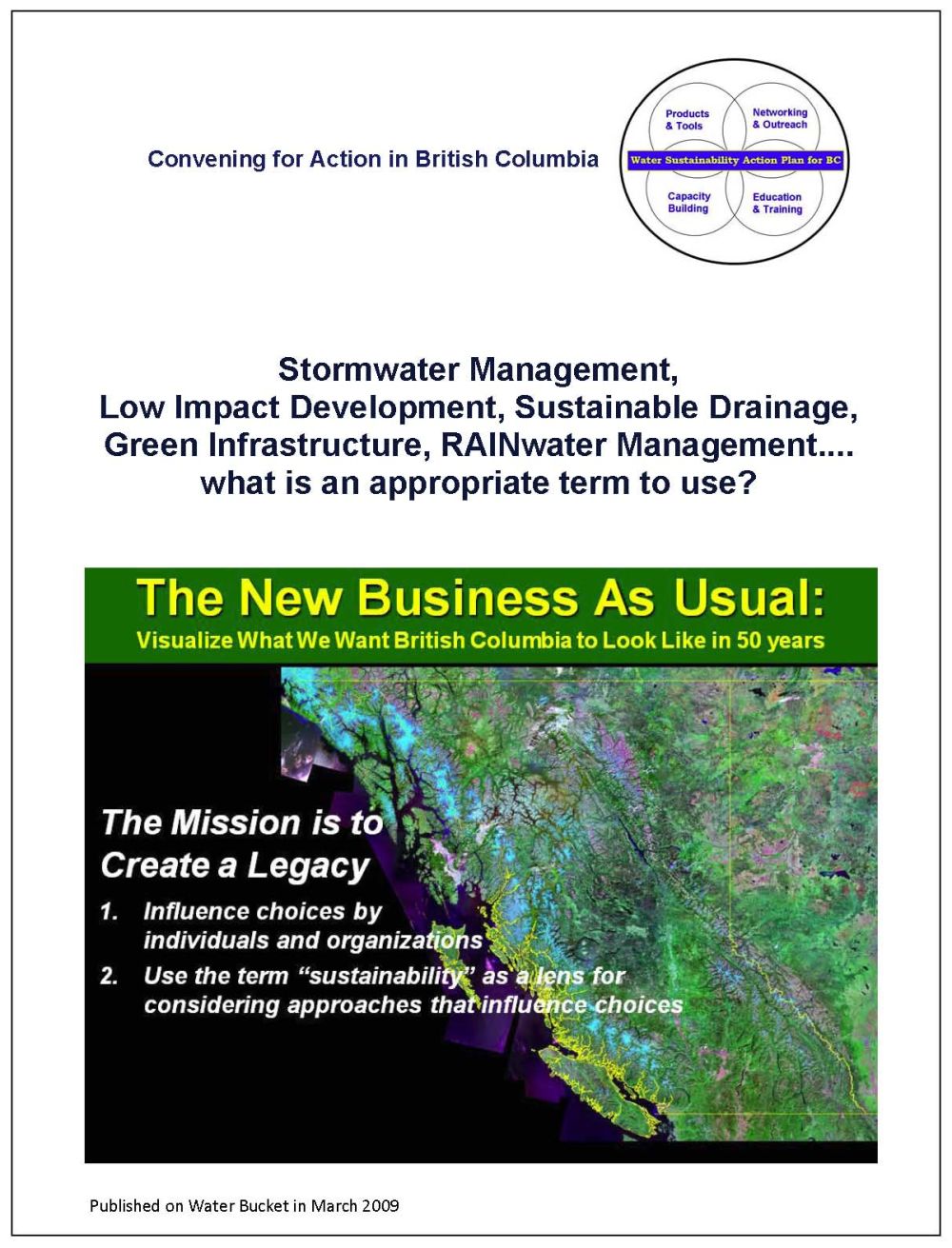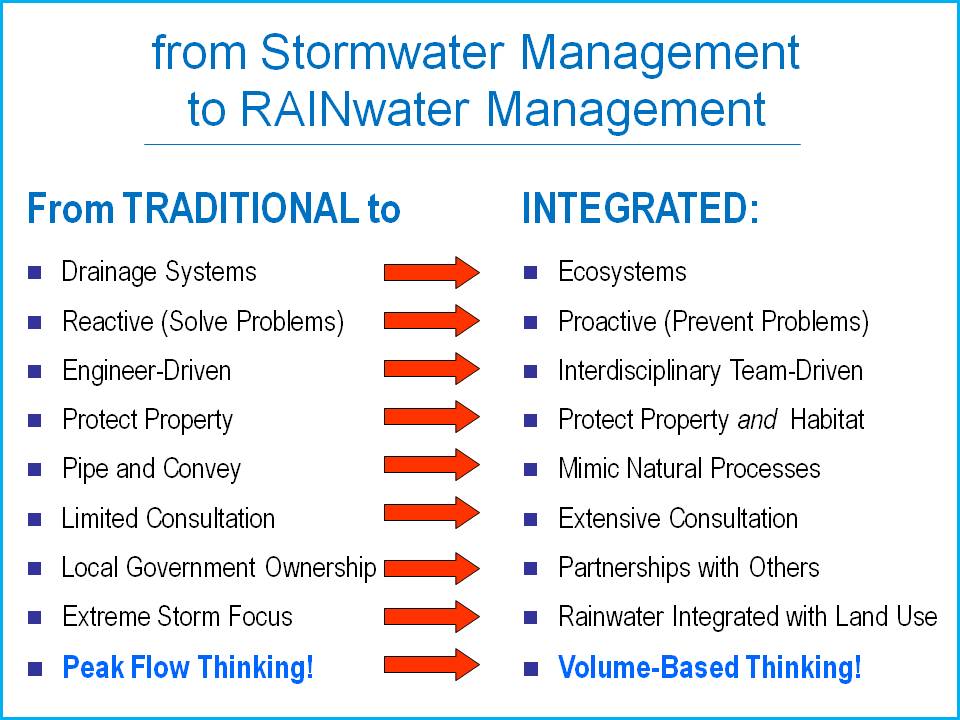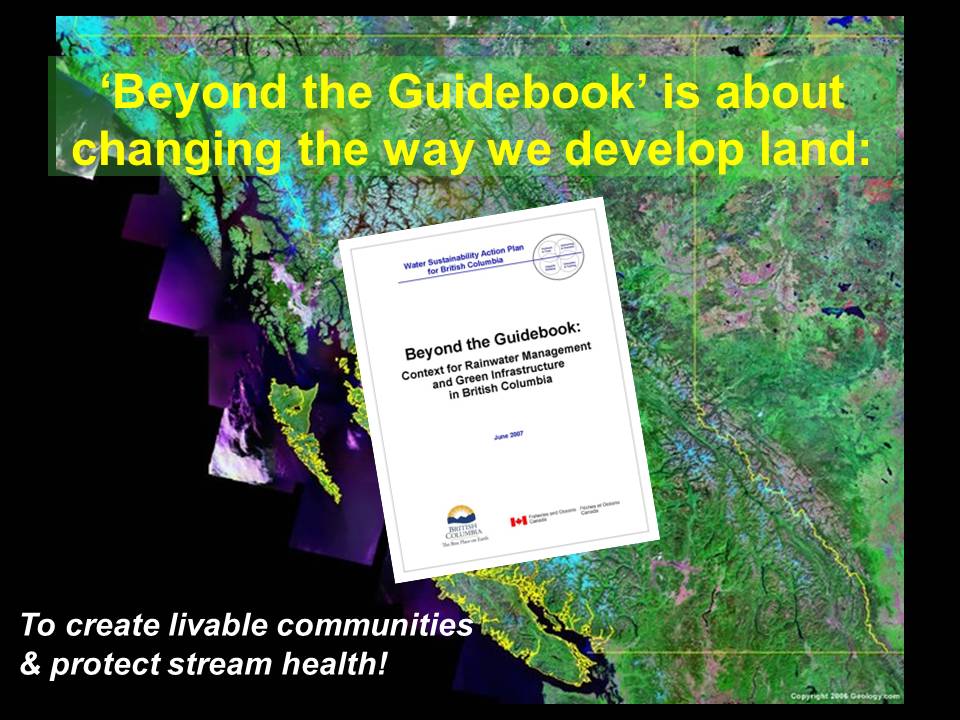Stormwater Management, Low Impact Development, Sustainable Drainage, Green Infrastructure, RAINwater Management…. what is an appropriate term to use?
Note to Reader:
The language used by drainage practitioners around the world has been changing to reflect the evolving objectives in doing business differently. Stormwater Management, Low Impact Development, Sustainable Drainage, Green Infrastructure, RAINwater Management.
What is an appropriate term to use? In British Columbia, the Water Sustainability Action Plan is endeavouring to provide clarity of meaning so that there will be consistency of understanding province-wide. This led to release of an explanatory document in March 2009.
To download a PDF version of the article that follows, click on Stormwater Management……what is an appropriate term to use?
Context
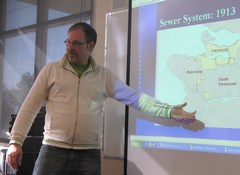 “The language used by drainage practitioners around the world has been changing. Unfortunately, there does not yet appear to be a common set of definitions or vocabulary, with each region of the English speaking world using different terms. So, which term is appropriate and relevant to use? In British Columbia, the Water Sustainability Action Plan is endeavouring to provide clarity of meaning so that there will be consistency of understanding province-wide,” ,” states Robert Hicks, Senior Engineer with Metro Vancouver and an experienced water resource practitioner.
“The language used by drainage practitioners around the world has been changing. Unfortunately, there does not yet appear to be a common set of definitions or vocabulary, with each region of the English speaking world using different terms. So, which term is appropriate and relevant to use? In British Columbia, the Water Sustainability Action Plan is endeavouring to provide clarity of meaning so that there will be consistency of understanding province-wide,” ,” states Robert Hicks, Senior Engineer with Metro Vancouver and an experienced water resource practitioner.
Is Low Impact Development Relevant in British Columbia?
“While the term Low Impact Development is used in the United States for some types of at source rainwater/ stormwater management techniques, in British Columbia we have found that the usage of this term is often a barrier to uptake and implementation,” observes Robert Hicks.
“From our BC perspective and experience, Low Impact Development is NOT exclusive to stormwater or rainwater management as it is a much broader classification of strategies that can include transportation, housing densities, etc. Regrettably, it seems to be associated with impressions of ‘higher cost’ and ‘higher risk’ in the development community. In BC, we have used ‘SmartGrowth’ as an alternate to this, and even this terms seems to be used less and less, in part because it is seen to be value-laden.”
“Another point is that the Metro Vancouver region is primarily in renewal, retrofit, and redevelopment phases, with new development playing less of a role in affecting the long-term health of urban waterways. The term Low Impact Development does not intuitively reflect this.”
How to Provide Clarity of Meaning?
“It is important to use descriptions which are linked more closely with the objectives and ideas – stormwater, sustainability, runoff, rainwater, infrastructure, etc,” continues Robert Hicks. “Ideally, the right choice of wording will frame the concepts clearly, and provide the terminology with some longevity. Clarity will help with uptake – jargon and anachronism needs to be avoided as they can obscure the objectives and ideas.”
“In Germany, it is Regenwasser (rainwater) and Nahenatur Entwaesserung (near natural drainage). In the UK, ‘sustainable urban drainage systems’ (SUDS) is used. The use of these terms have inspired many BC rainwater management professionals to focus on function and solution – site level, rainwater, green, integrated, infrastructure, etc. As a result, terms like ‘on-site rainwater management’, ‘at source rainwater management’, ‘runoff source-control’, ‘site-level stormwater’, and ‘green infrastructure’ are used in BC and are becoming part of the provincial government’s vocabulary.”
“Another perspective is perhaps that stormwater is the contaminated, concentrated dirtied runoff, while rainwater is the pure resource. We have spend much effort dealing with problems created through a lack of integrated management, only to realise that the most effect management is at the source, and the resource level.”
“There is not yet a single common term in use in BC, but there appears to be very positive acceptance of these terms by the various audiences. They more clearly link to the function and purpose. The term Low Impact Development does not provide the same meaning across Canada; and I believe it is likely to become outdated jargon,” concludes Robert Hicks.
From Stormwater Management to RAINwater Management
“Choice of words is important; hence, changing the technical language is part of the process of advancing green infrastructure practices. We are weaning drainage practitioners away from a single-objective stormwater management way of thinking and designing…. to a way of doing business that is holistic, namely RAINwater management,” states Kim Stephens, Program Coordinator for the Water Sustainability Action Plan for British Columbia.
“Increasingly, we have observed that the term RAINwater management resonates with non-engineers and the community at large. They intuitively get it. RAINwater management is about integration and an interdisciplinary approach that is landscape-based, and therefore goes well beyond the narrow engineering definition for conventional stormwater management.”
“When I graduated from university in 1973, we called it drainage. Then in the mid-1970s the term stormwater management appeared in the literature,” explained Stephens, “As far as I can determine, this terminology originated with the ‘pipe guys’ who were primarily concerned with making the distinction between sanitary and storm flows in combined sewer systems. Unfortunately, continued use of the term stormwater management only serves to perpetuate an outdated way of thinking.”
“RAINwater management is at the heart of green infrastructure,” concludes Kim Stephens. “The two go hand-in-hand, yet green infrastructure is not exclusively about RAINwater management.”
RAINwater Management is Landscape-Based
In November 2007, the Capital Regional District organized a Rainwater Management Workshop. Paul de Greeff, landscape planner, delivered a thought-provoking presentation that opened with this question: What is innovative rainwater management, and why should we pursue it as municipalities and developers?
 “If we view innovative rainwater management comprehensively, it starts with an understanding of site processes, systems and context,” stated Paul de Greeff. “If we don’t first understand the systems that we are designing within, and the full breadth of constraints and opportunities present on a site, fitting rainwater management systems into the landscape is a bit like making a medical diagnosis and prescription without first taking a patient history, lab tests or in any way trying to understand the patient.”
“If we view innovative rainwater management comprehensively, it starts with an understanding of site processes, systems and context,” stated Paul de Greeff. “If we don’t first understand the systems that we are designing within, and the full breadth of constraints and opportunities present on a site, fitting rainwater management systems into the landscape is a bit like making a medical diagnosis and prescription without first taking a patient history, lab tests or in any way trying to understand the patient.”
“An appreciation that every site is different and has different needs or resiliencies is an essential first step for addressing innovative rainwater management.
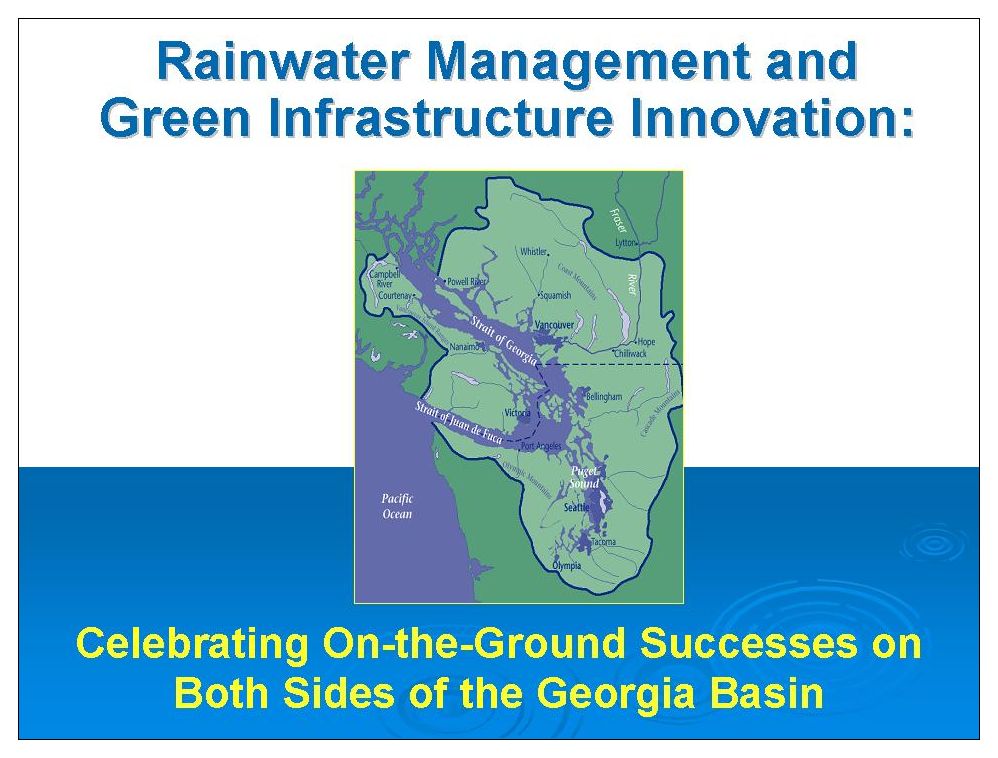
City of Portland Coins RAIN Acronym
At the Water in the City Conference held in Victoria, British Columbia in September 2006, Tom Liptan of Portland, Oregon informed his Canadian audience that the City Portland has coined the acronym RAIN to contrast contemporary ‘rainwater management’ with traditional ‘stormwater management’, where:
RAIN = Retaining and Integrating Nature
A landscape architect with the Bureau of Environmental Services, Tom Liptan has been the driving force behind the research and development of new urban techniques, codes and policies in the City of Portland.
 When he began his 90-minute presentation, Tom Liptan commented that “It is great to see that the Province of British Columbia is proactively encouraging the drainage community to start using the all-encompassing Rainwater Management as an alternative to single-objective Stormwater Management.”
When he began his 90-minute presentation, Tom Liptan commented that “It is great to see that the Province of British Columbia is proactively encouraging the drainage community to start using the all-encompassing Rainwater Management as an alternative to single-objective Stormwater Management.”
“The language-shift that you have initiated in British Columbia is what we would like to see happen in Portland. This is one reason why the Bureau of Environmental Services has coined the RAIN acronym. We believe this will help promote changes in thinking and practice so that we achieve beneficial outcomes.”
“Traditional stormwater management has a narrow scope, is event-based, and only considers a handful of runoff events that might occur in a given year. Rainwater management, on other hand, accounts for all the rainfall-days that occur each year.”
“Rainwater management is all about developing in a way that restores the function and value of trees, soil and open space in our communities. If we develop today with long-term sustainability in mind, future generations can enjoy a vibrant city and clean and healthy rivers, instead of bearing the burden of our actions”, concluded Liptan.

What We Are Trying to Achieve in British Columbia
“In February 2009, the British Columbia Ministry of Community Development sent out a circular to all Municipal and Regional District Chief Administrative Officers, Engineers and Planners to draw attention to Beyond the Guidebook: Context for Rainwater Management and Green Infrastructure in British Columbia,” notes Kim Stephens.
 “Released in June 2007, Beyond the Guidebook focuses on desired outcomes. RAINwater management is a means to an end to change the way land is developed…so that we can create liveable communities and protect stream health.”
“Released in June 2007, Beyond the Guidebook focuses on desired outcomes. RAINwater management is a means to an end to change the way land is developed…so that we can create liveable communities and protect stream health.”
“The Beyond the Guidebook framework and direction for rainwater management and green infrastructure reflects a ‘design with nature’ approach to climate change adaptation and managing risk.”
How We Develop Land
 “We really have to look at how we develop land. Ultimately this requires leadership and champions on the ground. The message is that the Province is rewarding good behaviour,” states Glen Brown, Executive Director, Local Government Infrastructure and Finance Division of the Ministry of Community Development.
“We really have to look at how we develop land. Ultimately this requires leadership and champions on the ground. The message is that the Province is rewarding good behaviour,” states Glen Brown, Executive Director, Local Government Infrastructure and Finance Division of the Ministry of Community Development.
“Beyond the Guidebook is an on-the-ground application of Living Water Smart. It helps focus the attention of local governments and the development community on what is an achievable outcome that makes sense, and results in net environmental benefits at a watershed scale.”


